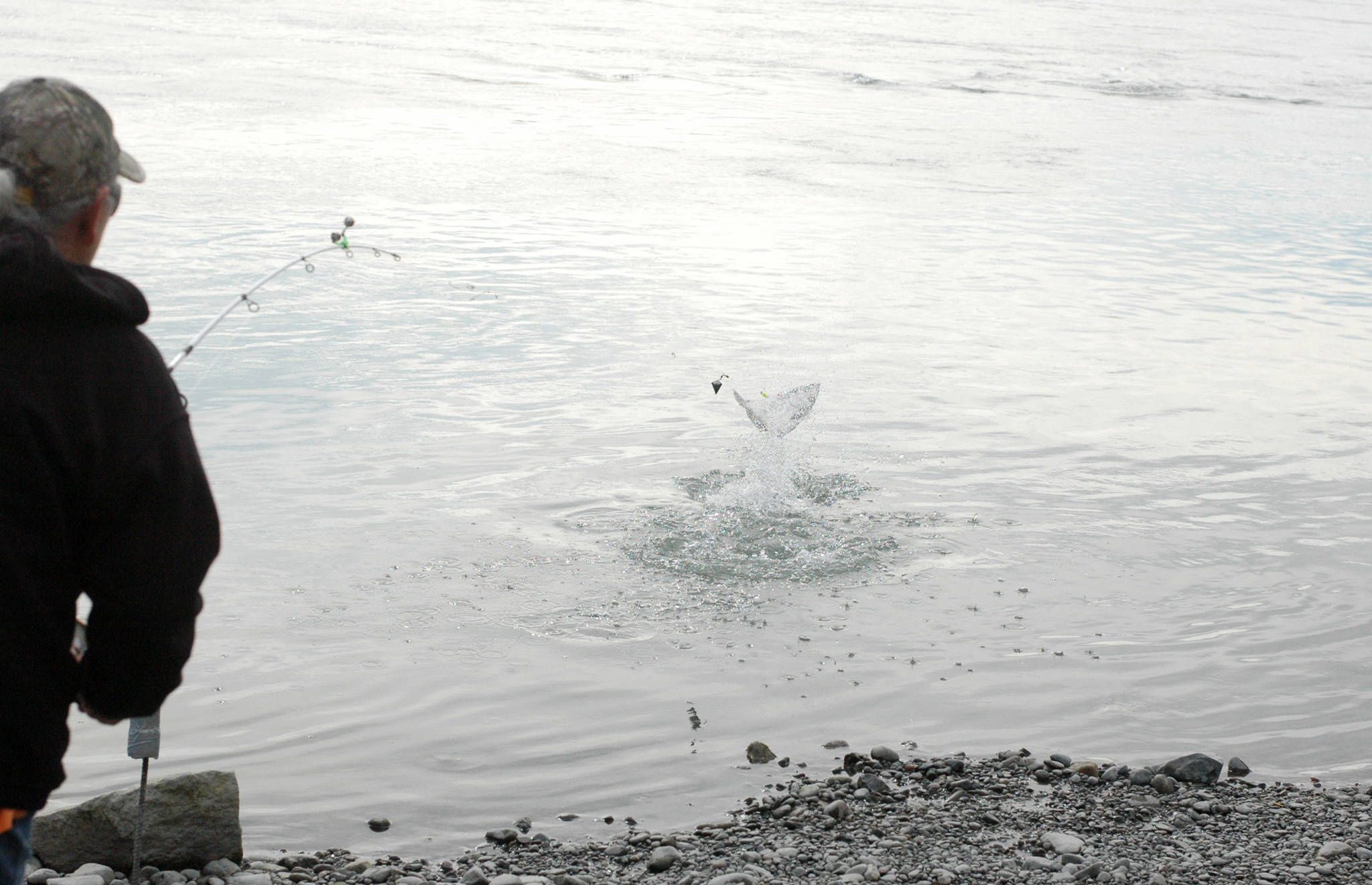Kenai Peninsula local’s process for catching pink salmon:
—Throw a line out.
—Get a tug, catch a glimpse of the prominent dark hump on the back of a pink salmon. Groan.
—Successfully wrestle it to the bank.
—Retrieve lure. Release pink without a second thought.
Though they’re plentiful and easy to catch, many Alaskans will turn up their noses at pink salmon. One reason is that they’re not as good to eat as kings, silvers and sockeye — once they leave the ocean and hit freshwater, the meat tends to lose quality fairly quickly. They also generally don’t put up as much of a fight for anglers as the other species do.
But they are plentiful. Just below the Sterling Highway bridge in Soldotna on Wednesday morning, anglers in search of silvers hooked into pink after pink, and their dark backs and tails frequently broke the surface of the river with a splash.
Pink salmon run in large numbers to Upper Cook Inlet streams on even-numbered years, including this year. They generally start running in early August and continue into September, growing increasingly colorful as the season goes on. The Alaska Department of Fish and Game allows anglers to keep up to 10 per day with 10 in possession for pinks shorter than 16 inches, and six per day with six in possession for those 16 inches or longer.
They’re brighter downstream at the tidewater, when they first come in. While the anglers upstream Wednesday readily tossed the colorful fish back, some at Cunningham Park in Kenai hung onto them for their larders.
But most people are still after the big, bright silvers that are the mainstay of the Kenai River in the late summer and fall. Though silver fishing was good earlier in August, it’s since slowed down. At Cunningham Park on Wednesday afternoon, anglers reported a slow week, with only a few anglers successfully pulling in fish in the past few days. However, several said they weren’t surprised — the silver runs on the Kenai River are usually split into two, with the first run tapering off in late August and picking back up in September.
After September 1, anglers on the Kenai River can keep three silvers 16 inches or longer per day with six in possession, per Fish and Game regulations. For the third and fourth weekends in September, they also have a chance to win prizes for their silver salmon in the Kenai Chamber of Commerce’s second annual silver salmon derby, set for Sept. 14–16 and Sept. 21–23. Unlike other derbies, the prizes don’t go to the heaviest fish — instead, the fish that’s closest to the “magic weight,” determined by spinning a wheel for daily and overall weights, wins the prize. Tickets cost $25 for adults and $15 for youth daily or $100 for adults and $50 for youth for the full derby. Fish can be weighed at the Three Bears in Kenai from 8 a.m.–8:30 p.m. Friday and Saturday and 9 a.m.–7:30 p.m. Sunday.
Sockeye fishing reopened on the Kenai River last Thursday as a late pulse of fish showed up, though anglers on the banks this week didn’t report much luck catching sockeye headed upriver. The counts past Fish and Game’s sonar on the Kenai River have tapered off as well, with 19,651 fish past the sonar on Aug. 25 but only 1,436 passing on Tuesday, with a total of 1.03 million past the sonar since July 1.
Trout and Dolly Varden are also major target species on the northern Kenai Peninsula as the fall goes on, both in lakes and in rivers. Anglers can only keep rainbow trout and Dolly Varden on the Kenai River that are shorter than 16 inches, with a limit of one per day with one in possession, though many anglers also go catch-and-release fishing on the upper Kenai River for trout in the fall.
On the lower Kenai Peninsula, Dolly Varden are reportedly dispersed throughout the Anchor and Ninichik rivers and Deep Creek, with fishing fair to good, according to the sportfishing report for that area issued Tuesday. Coho fishing was slow last week, with some fresh fish entering the streams on incoming tides.
The Homer Jackpot Halibut Derby, which runs all summer, ends in two weeks on Sept. 15. The largest halibut to be brought in with a derby ticket wins $5,000, with monthly big fish and tagged fish prizes throughout the season as well. The leader as of Aug. 20 was Ashley Camp of Vancouver, British Columbia with a 221.4-pound halibut.
Reach Elizabeth Earl at eearl@peninsulaclarion.com.

